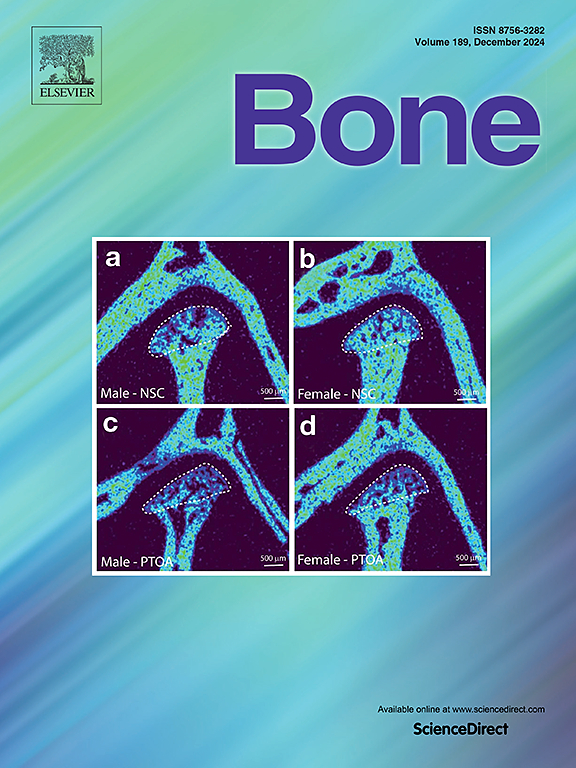Molecular mapping of articular cartilage CXCR4 expression after ACL injury via a novel small molecule-based probe
IF 3.6
2区 医学
Q2 ENDOCRINOLOGY & METABOLISM
引用次数: 0
Abstract
Purpose
Molecular imaging is a powerful modality to spatially resolve molecular changes across tissues, but application to articular cartilage remains limited. CXCR4 is an established marker of chondrocyte hypertrophy and potential therapeutic target for osteoarthritis. The purpose of this study was to develop and apply a CXCR4-targeted, near-infrared fluorescent (NIR) probe to a rat model of post-traumatic osteoarthritis (PTOA).
Methods
A CXCR4-targeted, small molecule-based NIR probe (“Cy7-AMD”) was synthesized. Sensitivity and specificity of Cy7-AMD to CXCR4 was validated in vitro (HUVECs), and ex vivo (rat osteochondral explants). To induce PTOA, female Lewis rats underwent noninvasive anterior cruciate ligament (ACL) rupture. At 7- and 28-days post-injury, injured/contralateral femora and tibiae were dissected, incubated in Cy7-AMD vs a non-targeting control, and imaged via NIR imaging, as well as conventional and contrast-enhanced micro-computed tomography. Imaging datasets were co-registered, cartilage tissue volumes were segmented, and paired cartilage thickness and NIR signal maps were generated and analyzed for PTOA-relevant changes.
Results
Compared to a non-targeting control probe, in vitro and ex vivo assays confirm sensitivity and specificity of Cy7-AMD to CXCR4. Flow cytometry confirmed high correspondence between Cy7-AMD- and antibody-based measurement of CXCR4 expression. Cy7-AMD rapidly equilibrated within cartilage, and fluorescent histology confirmed full-thickness penetration. Injured femoral cartilage exhibited heterogeneous CXCR4 expression, with increased signal deviation compared to contralateral femora. Spatial CXCR4 expression patterns correlated to cartilage thickness patterns; high CXCR4 expression at boundaries of low-thickness lesions suggests an association between CXCR4 expression and cartilage loss.
Conclusions
Small molecule-based probes are advantageous for mapping spatial patterns of molecular expression in rodent articular cartilage, deepening our understanding of PTOA progression.

基于新型小分子探针的前交叉韧带损伤后关节软骨CXCR4表达的分子定位
目的分子成像是一种强大的空间分辨组织分子变化的方法,但在关节软骨中的应用仍然有限。CXCR4是软骨细胞肥大的标志物,是骨关节炎的潜在治疗靶点。本研究的目的是开发一种靶向cxcr4的近红外荧光(NIR)探针,并将其应用于创伤后骨关节炎(pta)大鼠模型。方法合成一种靶向cxcr4的小分子近红外探针(Cy7-AMD)。体外(HUVECs)和体外(大鼠骨软骨外植体)验证了Cy7-AMD对CXCR4的敏感性和特异性。为了诱导上睑下垂,雌性Lewis大鼠进行了无创前交叉韧带(ACL)断裂。在损伤后7天和28天,解剖损伤/对侧股骨和胫骨,在Cy7-AMD和非靶向对照中孵育,并通过近红外成像,以及常规和对比度增强的微计算机断层扫描成像。对成像数据集进行联合注册,对软骨组织体积进行分割,生成配对软骨厚度和近红外信号图,并分析与pta相关的变化。结果与非靶向对照探针相比,体外和离体实验证实了Cy7-AMD对CXCR4的敏感性和特异性。流式细胞术证实了Cy7-AMD-和基于抗体的CXCR4表达测量之间的高度对应。Cy7-AMD在软骨内迅速平衡,荧光组织学证实了全层渗透。受伤股骨软骨表现出不均匀的CXCR4表达,与对侧股骨相比,信号偏差增加。CXCR4空间表达模式与软骨厚度相关;低厚度病变边界处CXCR4高表达提示CXCR4表达与软骨损失之间存在关联。结论基于小分子的探针有利于绘制啮齿动物关节软骨分子表达的空间格局,加深我们对PTOA进展的理解。
本文章由计算机程序翻译,如有差异,请以英文原文为准。
求助全文
约1分钟内获得全文
求助全文
来源期刊

Bone
医学-内分泌学与代谢
CiteScore
8.90
自引率
4.90%
发文量
264
审稿时长
30 days
期刊介绍:
BONE is an interdisciplinary forum for the rapid publication of original articles and reviews on basic, translational, and clinical aspects of bone and mineral metabolism. The Journal also encourages submissions related to interactions of bone with other organ systems, including cartilage, endocrine, muscle, fat, neural, vascular, gastrointestinal, hematopoietic, and immune systems. Particular attention is placed on the application of experimental studies to clinical practice.
 求助内容:
求助内容: 应助结果提醒方式:
应助结果提醒方式:


